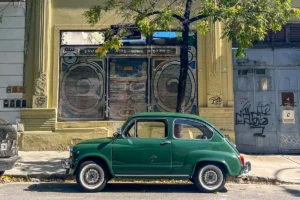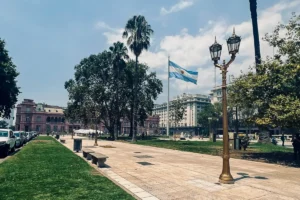
Self-Guided Tour AddOns: More Ways to Explore BA Differently
We last reviewed this post on July 24th, 2025 More things to do in Buenos Aires—perfect solo ideas or additions to existing routes Beautiful neighborhoods,
You might be wondering, “What is the dólar blue?” Well, in this post, we will provide you with all the information you need about it. Additionally, you’ll discover the most convenient places to exchange USD bills in Buenos Aires and some valuable advice for the transaction.


The “Dolar Blue” refers to the unofficial market price of the US dollar in Argentina. Given that its value often surpasses that of the “official dollar,” it tends to pique the interest of foreigners seeking advantageous transactions.
For those embarking on their first trip to Argentina, the intricacies of our informal economy might be unfamiliar terrain.
There exist numerous aspects of our culture that don’t easily lend themselves to explanation – take the tradition of mate drinking, for instance! However, when it comes to the economy, the “Dolar Blue” typically captures the attention of tourists.
The Argentine economy is no stranger to turbulence. Depending on its prevailing state, the divergence between the official dollar and the blue dollar can expand to as much as 100%!
Crucially, it’s worth noting that acquiring US dollars within Argentina is subject to substantial restrictions. Consequently, withdrawing American dollars from an ATM is not a feasible option. Instead, such cash must be brought in from abroad.

Let’s delve into an illustrative example with specific numbers. Imagine you arrive in Argentina carrying USD 100 and wish to convert them into the local currency, the “peso” (AR$).
Suppose you opt for a transaction at an exchange bureau or an official bank, such as Banco Nación. As of today (May 2025), the exchange rate for your USD would stand as follows:
USD 100 = AR$111000*.
However, if you decide to exchange your funds in the parallel market, the transaction would yield significantly more favorable results. Under the blue dollar exchange rate, your transaction would translate to:
USD 100 = AR$115500* (May 2025).
Furthermore, it’s essential to consider a crucial aspect when withdrawing money using your credit or debit card. The exchange rate applied to these transactions aligns with the official rate, rendering it less advantageous than converting physical cash within Argentina.
*Please note that these figures can undergo rapid fluctuations! They generally experience upward trends, owing to the inherent instability of the Argentine economy. Consequently, we’ll provide you with links where you can access the most up-to-date exchange rates whenever needed:
Official Dollar: Banco Nación www.bna.com.ar
Dolar Blue: preciodolarblue.com.ar

Indeed, our economy’s unpredictability is nothing short of remarkable, and Western Union emerges as the pinnacle choice for securing the most favorable exchange rate.
Certainly, we are asserting that Western Union provides a superior exchange rate compared to the official dollar valuation and, in some instances (currently), even surpassing the blue dollar rate.
As of today (May 2025), Western Union offers the following rates:
USD 100 = AR$112000
You can verify the exchange rate here: Price Estimator
For foreign tourists, executing this transaction is remarkably straightforward. All you need to do is download the Western Union app, visit one of their branch offices, initiate the money transfer, and receive your cash.
For a step-by-step guide on sending and receiving money through Western Union, refer to this link: Western Union
This approach stands as the simplest and most expedient route for foreign tourists to secure the best possible exchange rate when converting US dollars to Argentine pesos.

You might be pondering how intricate this process could be for a foreigner. It’s understandable if all of this appears somewhat convoluted.
In reality, exchanging dollars at the “Blue Dollar” rate is remarkably accessible for everyone.
Furthermore, it’s crucial to emphasize that participating in currency exchange through the parallel market is neither unlawful nor subject to legal penalties. It merely constitutes a private transaction among individuals—some selling, others purchasing.
Frequently, hotels or apartment rental managers (such as those on platforms like Airbnb) offer exchanges of USD at the blue exchange rate. Inquiring with them initially could be a prudent move.
If they do not provide the expected exchange rate, which you can verify on the previously mentioned website, there’s no need to worry. Exchanging your cash currency in downtown Buenos Aires is straightforward.
The Florida pedestrian street, located in the city center, stands as a haven for the blue dollar exchange.
This bustling street is precisely where you’ll encounter individuals right on the street who can facilitate the exchange of your USD for AR$.
As you stroll along, you’ll hear scores of people chanting “cambio, cambio, dolar, real, euro, cambio” or simply “cambio, cambio.” It’s almost like a rhythmic chorus. I know, it might sound like a playful jest, but it’s indeed accurate.
The individuals who vocally offer “cambio, cambio” are commonly referred to as “Arbolitos” (which translates to “little trees” in Spanish). The analogy is quite apparent. Firstly, the association of green leaves with the green USD bills is evident. Secondly, consider that these individuals are consistently stationed at the same spot—much like trees, naturally.
Engaging with an “arbolito” won’t present a challenge in terms of contact. They’ll typically approach you the moment an opportunity arises, offering their services for money exchange. Moreover, initiating a conversation by approaching them directly should prove to be quite effortless.
For the USD bills you wish to exchange, they should be in impeccable condition. Additionally, it’s preferable if they’re in denominations of USD 50 or USD 100 (higher-value banknotes produced after 1997). Failing that, you might receive a less favorable rate.
Here’s another crucial piece of information to remember. It’s possible that they’ll suggest heading to an office within the vicinity to finalize the transaction. This might also transpire within a shop or an office situated within a shopping gallery. It could even occur at a newsstand functioning as an unofficial exchange hub!
We understand that this might seem somewhat daunting to those unaccustomed to such exchanges, but it’s generally not a perilous undertaking. In fact, we’ve never heard of negative experiences. These individuals take their role quite seriously, treating it as a legitimate occupation.

It’s advisable to visit Florida Street between 11 am and 6 pm, as this is when most “arbolitos” engage in money exchange activities. You can also find “arbolitos” on weekends.
Once again, safety concerns should generally not be a significant issue, both in terms of the transactions and your presence in the area. Law enforcement presence is usually prominent due to the street’s location in the city center, with numerous banks in the vicinity.
In any event, it’s recommended not to exchange large sums of money all at once. Opt for smaller amounts of USD for exchange. Additionally, remember that this could result in a substantial number of AR$ bills, which might occupy considerable space in your bag or backpack.
Here’s a piece of advice: As a foreign tourist, traders might attempt to offer you a rate lower than what the website (previously mentioned) indicates. However, by displaying the quote you’re anticipating to receive on your phone, you demonstrate your awareness of the current rates. This usually suffices to seal the deal, and they should not reject the published rate.
Concerns about counterfeit peso bills might also arise, but we haven’t encountered any negative experiences in this regard. It’s important to recognize that distributing counterfeit banknotes is a criminal offense, which disincentivizes “arbolitos” from engaging in such activities to avoid legal ramifications.
Moreover, in a separate post, we’ll provide guidance on how to spot fake bills.

We last reviewed this post on July 24th, 2025 More things to do in Buenos Aires—perfect solo ideas or additions to existing routes Beautiful neighborhoods,

We last reviewed this post on July 24th, 2025 Elegance, art, and architecture in Recoleta, Retiro and Palermo Chico If you’ve ever wondered why Buenos

We last reviewed this post on July 24th, 2025 Lakes, gardens, and leafy escapes in Palermo’s most beloved parks. If you feel like taking a

We last reviewed this post on July 24th, 2025 Modern marvels, political landmarks, and architectural gems in the city center When you think of Buenos

We last reviewed this post on July 24th, 2025 Colonial streets, colorful facades, fútbol passion, and a riverside full of surprises. Welcome to the birthplace

We last reviewed this post on July 24th, 2025 Welcome to Buenos Aires — a city that’s both European and Latin American, modern and nostalgic,